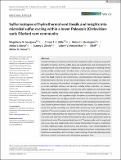Files in this item
Sulfur isotopes of hydrothermal vent fossils and insights into microbial sulfur cycling within a lower Paleozoic (Ordovician‐early Silurian) vent community
Item metadata
| dc.contributor.author | Georgieva, Magdalena N. | |
| dc.contributor.author | Little, Crispin T. S. | |
| dc.contributor.author | Herrington, Richard J. | |
| dc.contributor.author | Boyce, Adrian J. | |
| dc.contributor.author | Zerkle, Aubrey L. | |
| dc.contributor.author | Maslennikov, Valeriy V. | |
| dc.contributor.author | EIMF | |
| dc.contributor.author | Glover, Adrian G. | |
| dc.date.accessioned | 2022-05-19T16:30:09Z | |
| dc.date.available | 2022-05-19T16:30:09Z | |
| dc.date.issued | 2022-05-18 | |
| dc.identifier | 279664561 | |
| dc.identifier | 18ac0b63-4281-4d29-ab16-5d62db0ca253 | |
| dc.identifier | 000797101800001 | |
| dc.identifier | 85131891537 | |
| dc.identifier.citation | Georgieva , M N , Little , C T S , Herrington , R J , Boyce , A J , Zerkle , A L , Maslennikov , V V , EIMF & Glover , A G 2022 , ' Sulfur isotopes of hydrothermal vent fossils and insights into microbial sulfur cycling within a lower Paleozoic (Ordovician‐early Silurian) vent community ' , Geobiology , vol. Early View . https://doi.org/10.1111/gbi.12495 | en |
| dc.identifier.issn | 1472-4677 | |
| dc.identifier.other | Jisc: 326768 | |
| dc.identifier.other | publisher-id: gbi12495 | |
| dc.identifier.other | society-id: gbi-149-2021.r1 | |
| dc.identifier.other | ORCID: /0000-0003-2324-1619/work/113398955 | |
| dc.identifier.uri | https://hdl.handle.net/10023/25417 | |
| dc.description | This study was supported by a UK Natural Environment Research Council grant (NERC; number NE/R000670/1 to AG). MG is also grateful for support from an Ifremer Postdoctoral Fellowship. Alvinella samples were collected with the help of a NERC Small Grant (number NE/C000714/1 to CTSL). S isotopic analyses were undertaken under NERC Facility awards IP-1755-1117 and IMF672/1118. | en |
| dc.description.abstract | Symbioses between metazoans and microbes involved in sulfur cycling are integral to the ability of animals to thrive within deep‐sea hydrothermal vent environments; the development of such interactions is regarded as a key adaptation in enabling animals to successfully colonize vents. Microbes often colonize the surfaces of vent animals and, remarkably, these associations can also be observed intricately preserved by pyrite in the fossil record of vent environments, stretching back to the lower Paleozoic (Ordovician‐early Silurian). In non‐vent environments, sulfur isotopes are often employed to investigate the metabolic strategies of both modern and fossil organisms, as certain metabolic pathways of microbes, notably sulfate reduction, can produce large sulfur isotope fractionations. However, the sulfur isotopes of vent fossils, both ancient and recently mineralized, have seldom been explored, and it is not known if the pyrite‐preserved vent organisms might also preserve potential signatures of their metabolisms. Here, we use high‐resolution secondary ion mass spectrometry (SIMS) to investigate the sulfur isotopes of pyrites from recently mineralized and Ordovician‐early Silurian tubeworm fossils with associated microbial fossils. Our results demonstrate that pyrites containing microbial fossils consistently have significantly more negative δ34S values compared with nearby non‐fossiliferous pyrites, and thus represent the first indication that the presence of microbial sulfur‐cycling communities active at the time of pyrite formation influenced the sulfur isotope signatures of pyrite at hydrothermal vents. The observed depletions in δ34S are generally small in magnitude and are perhaps best explained by sulfur isotope fractionation through a combination of sulfur‐cycling processes carried out by vent microbes. These results highlight the potential for using sulfur isotopes to explore biological functional relationships within fossil vent communities, and to enhance understanding of how microbial and animal life has co‐evolved to colonize vents throughout geological time. | |
| dc.format.extent | 14 | |
| dc.format.extent | 2906797 | |
| dc.language.iso | eng | |
| dc.relation.ispartof | Geobiology | en |
| dc.subject | Chemosynthesis | en |
| dc.subject | Evolution | en |
| dc.subject | Microbiology | en |
| dc.subject | Paleobiology | en |
| dc.subject | Pyrite preservation | en |
| dc.subject | QH301 Biology | en |
| dc.subject | GE Environmental Sciences | en |
| dc.subject | DAS | en |
| dc.subject.lcc | QH301 | en |
| dc.subject.lcc | GE | en |
| dc.title | Sulfur isotopes of hydrothermal vent fossils and insights into microbial sulfur cycling within a lower Paleozoic (Ordovician‐early Silurian) vent community | en |
| dc.type | Journal article | en |
| dc.contributor.institution | University of St Andrews. School of Earth & Environmental Sciences | en |
| dc.contributor.institution | University of St Andrews. St Andrews Centre for Exoplanet Science | en |
| dc.contributor.institution | University of St Andrews. St Andrews Isotope Geochemistry | en |
| dc.identifier.doi | https://doi.org/10.1111/gbi.12495 | |
| dc.description.status | Peer reviewed | en |
This item appears in the following Collection(s)
Items in the St Andrews Research Repository are protected by copyright, with all rights reserved, unless otherwise indicated.

